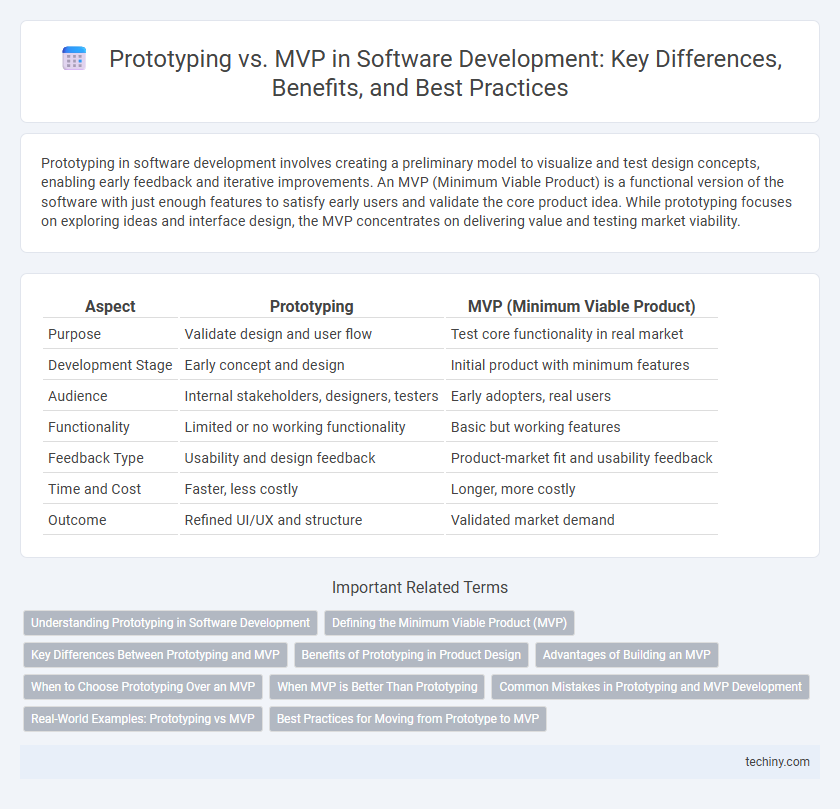Prototyping in software development involves creating a preliminary model to visualize and test design concepts, enabling early feedback and iterative improvements. An MVP (Minimum Viable Product) is a functional version of the software with just enough features to satisfy early users and validate the core product idea. While prototyping focuses on exploring ideas and interface design, the MVP concentrates on delivering value and testing market viability.
Table of Comparison
| Aspect | Prototyping | MVP (Minimum Viable Product) |
|---|---|---|
| Purpose | Validate design and user flow | Test core functionality in real market |
| Development Stage | Early concept and design | Initial product with minimum features |
| Audience | Internal stakeholders, designers, testers | Early adopters, real users |
| Functionality | Limited or no working functionality | Basic but working features |
| Feedback Type | Usability and design feedback | Product-market fit and usability feedback |
| Time and Cost | Faster, less costly | Longer, more costly |
| Outcome | Refined UI/UX and structure | Validated market demand |
Understanding Prototyping in Software Development
Prototyping in software development involves creating an early, interactive model of a product to visualize and test ideas before full-scale production. This process helps identify design flaws, gather user feedback, and refine functionality iteratively, reducing risks and development costs. By focusing on user experience and core features, prototyping accelerates communication among stakeholders and aligns project goals effectively.
Defining the Minimum Viable Product (MVP)
The Minimum Viable Product (MVP) in software development represents the core version of a product that includes just enough features to satisfy early adopters and gather validated learning for future iterations. Unlike prototyping, which focuses on exploring design concepts and feasibility, the MVP aims to deliver functional value and test market assumptions with real users. Defining the MVP requires identifying essential features that address primary user needs while enabling quick deployment and feedback collection.
Key Differences Between Prototyping and MVP
Prototyping involves creating a preliminary model to visualize and test design concepts with limited functionality, primarily focusing on user experience and interface validation. MVP (Minimum Viable Product) refers to a functional version of the software with essential features that deliver value to early adopters while enabling feedback collection for iterative improvements. The key difference lies in prototyping's role in exploring ideas and design, whereas MVP emphasizes delivering a usable product for market testing and validation.
Benefits of Prototyping in Product Design
Prototyping accelerates product design by enabling early visualization and user feedback, reducing costly revisions during development. It allows designers to test interface usability and functionality, ensuring alignment with user needs before coding begins. This iterative process minimizes risks and improves communication among stakeholders, leading to a more refined final product.
Advantages of Building an MVP
Building a Minimum Viable Product (MVP) accelerates time-to-market by releasing a functional version of the software that addresses core user needs, enabling early customer feedback and iterative improvements. MVPs reduce development costs and risks by focusing resources on essential features rather than extensive prototypes that may not validate market demand. This approach facilitates data-driven decisions, improves product-market fit, and increases the likelihood of successful scaling and investment.
When to Choose Prototyping Over an MVP
Choose prototyping over an MVP when the primary goal is to explore design concepts, gather early user feedback, and validate functionality before committing to full product development. Prototyping allows rapid iteration and testing of ideas without the constraints of a minimum viable product's feature set or market readiness. This approach is ideal for projects with high uncertainty where insights on user experience and interface design are critical to inform subsequent development phases.
When MVP is Better Than Prototyping
MVPs are better than prototyping when validating market demand through real user interactions and feedback is essential for product development. MVPs provide a functional, scalable version of the software with core features, enabling early monetization and iterative improvements based on actual usage data. This approach reduces time-to-market and investment risk by focusing on viable product delivery rather than conceptual design validation.
Common Mistakes in Prototyping and MVP Development
Common mistakes in prototyping include over-investing in high-fidelity designs that delay feedback and focusing on aesthetics rather than core functionality. In MVP development, teams often err by building overly complex features instead of validating the minimum value hypotheses efficiently. Both approaches suffer when user input is neglected, leading to products that miss market needs and increase time-to-market risks.
Real-World Examples: Prototyping vs MVP
Prototyping in software development serves as an early visualization tool, exemplified by Dropbox's initial clickable prototype, which helped validate user interest without building a fully functional product. In contrast, an MVP (Minimum Viable Product) like Airbnb's first version focused on delivering a usable service to early adopters, enabling real-world feedback to guide iterative development. These approaches illustrate that prototyping tests concept feasibility quickly, while MVPs test market readiness and user engagement with a functional solution.
Best Practices for Moving from Prototype to MVP
Transitioning from prototype to MVP requires prioritizing core functionalities that validate market demand while ensuring scalability and user feedback integration. Early deployment should focus on minimal but effective features to test assumptions and iterate quickly based on real user interactions. Employing agile development, continuous user testing, and clear versioning strategies accelerates refinement and reduces time-to-market.
Prototyping vs MVP Infographic

 techiny.com
techiny.com